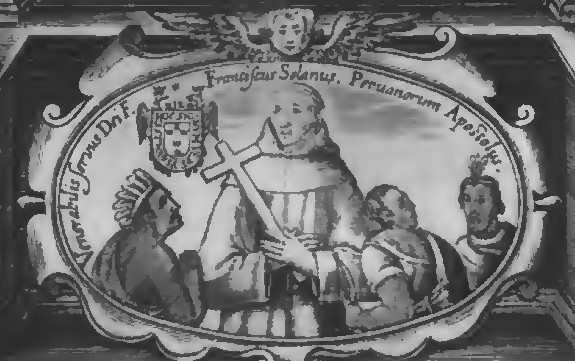Upon arrival in the Viceroyalty of Peru, Solano was sent to the Andean village of Tucumán in what is today Argentina, where he performed miraculous deeds. Birds followed him. A bull that had killed two Indians in the ring before breaking loose encountered Solano at the town plaza and became his pet. Solano devoted much of his time in Tucumán to singing to the natives of nearby Paraguay. He immediately learned many indigenous languages and preached to the natives in their tongues. The day an army of 6,000 Indians surrounded Tucumán, the Indians put down their arms and surrendered to the power of Christ. Solano returned from Tucumán and Paraguay to Lima, walking with cilices on his body and nails on his soles. He headed north to Trujillo in Peru to tend the emerging communities of slaves and Indians who laboured in the sugar mills of the Pacific coast. But it was in the Nineveh that was Lima where he performed most of his salvific work. Solano was a preacher who did not just pacify birds, bulls, African slaves and Paraguayan Indians. He also had the ability to terrify Spanish, Portuguese and Creole townsmen or vecinos. Solano was the Savonarola of Lima.
Solano, apostle of Indians and Africans
Solano, Peruvian apostle of Indians and Africans. Detail of frontispiece, Alonso Briceño, Prima pars celebriorum controuersiarum in primum sententiarum Ioannis Scoti (Madrid, 1642; public domain).
Jorge Cañizares-Esguerra
Further reading
- Gálvez Peña, C.M. (2008) ‘El carro de Ezequiel: la monarquía hispana de fray Buenaventura de Salinas y Córdova’, Histórica, 32 (1): 39–75.
- Gálvez Peña, C.M. (2011) ‘Sueños, profecías, visiones y política en las crónicas limeñas del siglo XVII’, in Los sueños en la cultura iberoamericana, siglos XVI–XVIII, edited by S.V. Rose, P. Schmidt, and G. Weber (Seville: Consejo Superior de Investigaciones Científicas).
- Jouve-Martín, J.R. (2004) ‘En olor de santidad: hagiografía, cultos locales y escritura religiosa en Lima, siglo XVII’, Colonial Latin American Review, 13 (2): 181–98.
- Rubial, A. (2006) Profetisas y solitarios: espacios y mensajes de una religión dirigida por ermitaños y beatas laicos en las ciudades de Nueva España (Mexico City: Fondo de Cultura Económica).





